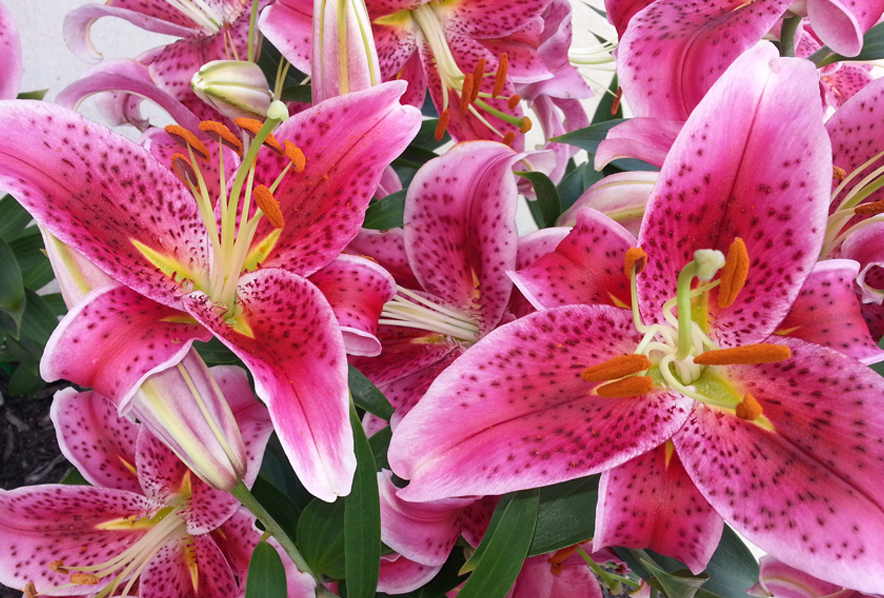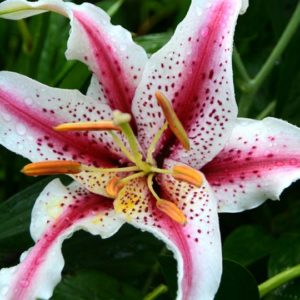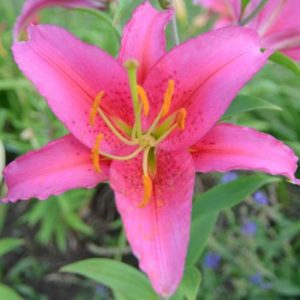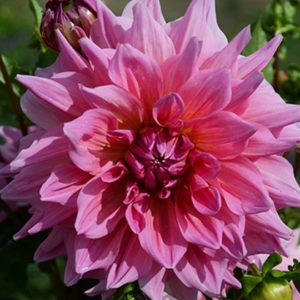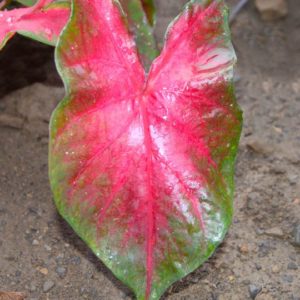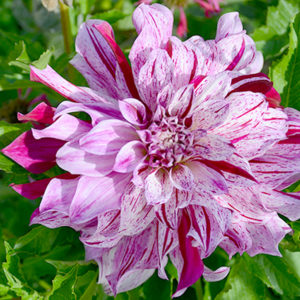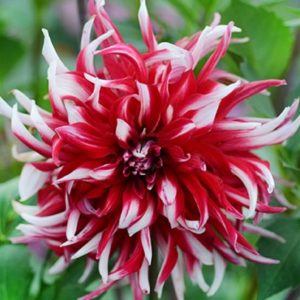Description
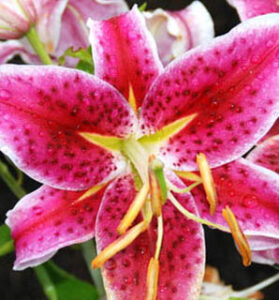 Oriental Lily,
Oriental Lily,
Stargazer
Lilies are believed to be some of the oldest plants in cultivation. Both the Greeks and the Romans cultivated the flowers and perhaps even older civilizations. Only one lily was known to Europeans prior to the 16th century. It was The Madonna Lily, and this was the lily brought by colonists to America in the 1630s.
Turk’s Cap lilies were introduced into Europe in 1596. Thomas Jefferson grew lilies from Greece at Monticello, and the Tiger Lily was popular in America by the 19th century.
In the horticulture world of today there are 7 major lily divisions: Asiatic, Martagon, Candidum, American Hybrids (Turk’s Cap), Longiflorum, Trumpet Hybrids and Oriental Hybrids. The Trumpets, the Martagon and the Longiflorum are the tallest, with the Trumpets being the tallest of all.
The Oriental Trumpets are largely the creation of Jan de Graaff of Oregon who along with his team developed the Oriental Trumpets and Oriental Hybrids throughout the 20th century.
The Tigrinum Lilies (L. lancefolium) along with the Martagon (L. martagon) and Candidum (L.candidum) lilies are the oldest cultivated lily species on earth. They are also among the tallest of all lily species reaching heights in excess of 60 inches. Tigrinum are native to Japan. The towering flower spikes of the Tigrinum produce 20 or more orange to pinkish tinged, 4-inch diameter blossoms with strongly reflexed petals that are covered with mahogany colored freckles.
The Martagon lilies are best known as “The Turk’s Cap” lilies and are native to most of Europe, northern Asia Minor, Siberia, northern Turkestan and Mongolia – some of the harshest climates on the face of this earth. They were introduced as cultivated plants in Europe in 1596. Martagons are very tall (6 feet+) and produce flowering stems yielding 50+ flowers per stem.
The lilium genus, surprisingly, is only indigenous to the temperate zones of the Northern Hemisphere, but it has been so popular for so many centuries that it is worldwide in distribution. There are many, many species native to North America, some highly fragrant, some not. Lilies were a part of the Greek and Roman civilizations. New World lilies and the lilies of China and Japan were quickly and eagerly embraced by Europeans and the British.
Since the Renaissance, the development and cultivation of lily cultivars has proliferated, but it was not until the late 1800s that the most significant lily introductions were created. E. H. Wilson (1876-1931), the Director of The Arnold Arboretum outside of Boston, MA introduced L. davidii, L. regale, and L. sargentiae. These three lily species became the most important lilies of the 20th century.
Asiatic Lilies are the most popular lilies grown today, and since the mid-20th century, more development work has been done on this group of lilies than all the rest. Most of the Asiatics available today have in their lineage the DNA of one of the greatest species lilies of all time, L. regale. L. regale was discovered in 1903 by Ernest “Chinese” Wilson, the Englishman who became the Director of The Arnold Arboretum, one of America’s most prestigious horticultural assets.
In her marvelous book, BULB, Anna Pavord relates the story of the Wilson’s discovery as described by Wilson himself. Wilson came across the lily, by accident, in a remote, inaccessible area of western China known as the Min Valley. He wrote,
“There in narrow, semi-arid valleys down which thunder torrents, and encompassed by mountains composed of mudshales and granites, whose peaks are clothed with snow eternal, the Regal Lily has its home. In summer the heat is terrific, in winter the cold is intense, and at all seasons these valleys are subject to sudden and violent windstorms against which neither man nor beast can make headway. There, in June, by the wayside, in rock crevices by the torrents edge, and high up on the mountainside and precipice, this lily in full bloom greets the weary wayfarer. Not in twos or threes, but in hundreds, in thousands, aye, in tens of thousands.”
Wilson, on this specific collecting trip gathered thousands of lily bulbs. Three thousand bulbs made it back to England and were cultivated. L. regale was introduced and made available to the British public in 1905. Its instant popularity has not diminished since.
Asiatic Lilies are so beloved because they tend to be shorter than either the Oriental Trumpets or the Orientals. Rarely are they taller than 30 inches. They are vigorous and love containers as well as the open garden. Some are fragrant; some are not. Their blossoms come in a wide range of colors and shapes. They epitomize every quality that we gardeners seek in a flower.
The Double Lilies, both Asiatic and Oriental, are the rarest of the lilies cultivated today. Few cultivars remain stable year after year. The cultivars offered by Harvesting History have remained stable in gardens for years.
Asiatic and Oriental lilies are often very similar in appearance and many astute and experienced gardeners see no difference in the two. However, there are differences and these can be substantial. Oriental lily plants grow taller than Asiatics. The flowers can be heavily fragrant and are usually much larger than the Asiatic blossoms. Orientals bloom much later than Asiatics so it is best to plant both Asiatics and Orientals for continuous blooms from early summer to fall.
Oriental lilies can be planted in the fall or the spring. If planting in the fall make sure the location does not become soaking wet in the winter or the bulbs will rot. Lilies can be planted in the spring as soon as the ground can be worked and up until mid-June. Lilies planted after mid-June may not bloom the first year.
Stargazer, along with Casa Blanca, are arguably the most famous lilies of all time. Surprisingly, Stargazer is a relatively new addition to the lily family having been introduced in 1974. This lily produces an abundance of blossoms (6-10 per plant in 2-3 years), but it is its unforgettable fragrance that has made this plant so popular. You will know the minute it has bloomed, because a sweet, gentle perfume will waft its way through the open windows in your home.
The blossoms will last from1-3 weeks depending on the weather. In the first year, the plants will reach a height of 30-36 inches, but in subsequent years the plants will grow to 40-44 inches.
Planting Lilies in Your Garden
Two important facts that must be remembered when cultivating lilies is that they cannot stand wet feet. They need well drained soil, and if they do not have this, they will rot quickly. The second fact is lily bulbs are never dormant. There is always some activity going on in the bulb. It can be strengthening due to seasonal exposure to cold, food transference from roots to scales and scales to the growing point or top growth production. Because of this constant activity, lilies must be handled gently at all times.
To plant lilies in the ground, dig holes that are 8-10 inches deep and dust the holes with bone meal (1/4 cup per bulb). Place the bulb in the hole, pointed side up, and fill the hole with soil. Lilies prefer organically rich soil, so mixing peat moss, compost, and/or dehydrated cow manure into the soil produces stronger plants and more flowers. The Oriental Trumpets and the Oriental lilies should be planted12-14 inches apart. The Asiatics should be planted 12-14 inches apart.
Once the lilies have emerged from the soil, you can fertilize with a blossom booster fertilizer, but you do not have to do this. You will still get beautiful blooms if you do not fertilize at all. Lilies also like their heads in the sun and their feet in the shade. This can be accomplished by planting low growing annuals like alyssum, ageratum or non-vining nasturtiums where you are also growing the lilies or planting the lilies beneath shrubs or perennials.
Planting Lilies in Containers
Lilies LOVE being grown in containers, but the containers must be deep – at least 10-12 inches. Use the soil mix described in detail in our Harvesting History YouTube video. Do not use prepared soil mixes.
The Best Soil Mix for Containers
Briefly the soil mix is 60% topsoil, 20% peat moss and 20% compost or dehydrated cow manure. You can plant according to the following chart:
| Type | 10-12 inch | 14 inch | 18 inch |
| Asiatics | 3 Bulbs | 5 Bulbs | 10 Bulbs |
| Orientals | 2-3 Bulbs | 3-5 Bulbs | 6-8 Bulbs |
| Oriental Trigrinum | 1 Bulbs | 1 Bulbs | 2 Bulbs |
Plant the bulbs 8 inches deep. Dust the hole with ¼ cup bone meal per bulb. Cover the bulbs with 8 inches of soil. Water heavily, but do not allow the pots to stand in water. Once the lilies have emerged from the soil, fertilize every two weeks with blossom booster fertilizer.
In the fall, when the top growth has died completely back, remove the dead growth and dust the surface of the soil with bone meal. Mulch with 2 inches of compost, if possible, or a mix of peat moss and dehydrated cow manure-5 parts peat moss to 1 part manure.
Make sure you water your lilies throughout the summer. Do not allow the pots to dry out.
Harvesting History has a collection of YouTube videos on Asiatic and Oriental Lilies. Click on the individual link to view each video.
LILIES-THEIR HISTORY AND BACKGROUND
PLANTING LILIES
ORIENTAL TRUMPET LILIES
ASIATIC LILIES
ORIENTAL LILIES PART I
ORIENTAL LILIES PART II

